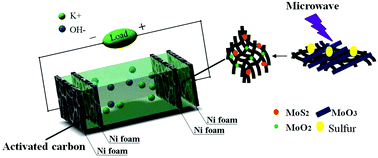Microwave synthesis of MoS2/MoO2@CNT nanocomposites with excellent cycling stability for supercapacitor electrodes†
Abstract
Herein, we present an ultrafast microwave approach for fabricating MoS2/MoO2@CNT nanocomposites toward supercapacitor electrodes with excellent cycle stability. The surface chemistry, crystalline structure and morphology of the as-produced nanocomposites were characterized by FTIR, XRD, XPS, EDS and SEM. It was found that MoS2/MoO2 nanoparticles could grow uniformly on the surface of CNTs, and the CNTs can provide a transport path for ions in electrolytes and reduce energy loss, thus leading to enhanced electrochemical performance of the resultant nanocomposites. Electrochemical results showed that the capacitance of the nanocomposite electrode was increased by 187.1% after 25 000 cycles at a current density of 5 A g−1, indicating outstanding cycling stability. Also, the maximum capacitance of the optimized MoS2/MoO2@CNT electrode can reach 228.4 F g−1 at 0.5 A g−1. Moreover, an asymmetric supercapacitor (MoS2/MoO2@CNT//AC) was assembled which exhibited a maximum energy density of 11.88 W h kg−1 and a power density of 2 kW kg−1, respectively. Intriguingly, the asymmetric supercapacitors could successfully light three LED lights for 5 minutes, showing their great practical application potential in portable supercapacitors.



 Please wait while we load your content...
Please wait while we load your content...